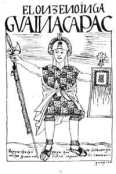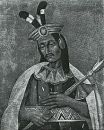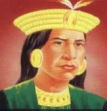Hello! This is part three of a multi-part series on the Inca Empire and the Conquistadors. If you want some background, the introduction to this series is right here, and part two is here. For those of you who prefer to remain blissfully ignorant, go ahead!
It’s hard to imagine how that first meeting could have gone better for the Spaniards. By capturing Atahualpa, the Spaniards had effectively crippled the Inca empire. The empire was organized in an almost exclusively top-down fashion, with the Inca giving orders to his generals and governors, which was then passed on to local leaders and eventually the peasants. No servant of the Inca would dare question or challenge the Inca’s orders, even if they were obviously given under duress. With Atahualpa in their power, the Spaniards could effectively give orders to the entire country.
What the Spaniards wanted from Atahualpa was gold. And a lot of it. They demanded a quite literal “king’s ransom” from Atahualpa, as much gold and silver as he could provide them. When Pizarro made this demand of Atahualpa, the Inca quite calmly offered to provide the Spanish with enough gold and silver to fill a room (22 feet by 17 feet) to a height as far as he could reach. One has to imagine that Pizarro’s jaw dropped when the offer was made.

Atahualpa demonstrates the size of the ransom
Men from across the Inca empire were mobilized to bring this huge ransom to Cajamarca. Gold cups, plates and utensils were brought from around the empire. Massive pieces of jewelry were added to the ransom hoard, as was the very gold plating from the temple walls. The Inca’s power was so absolute, and the Spanish hold on him so strong, that Inca soldiers escorted three Spaniards all the way from Cajamarca to the Inca capital of Cuzco. The Spaniards were sent in order to oversee and speed up the ransom payment, and they were carried deep into hostile territory on litters, with fresh food and alcohol brought to them whenever they wished. No one lay a hand on the Spaniards, not even the Inca general in Cuzco. That general’s name was Quizquiz, and he would eventually become one of the Spaniards’ fiercest enemies. For now, though, with explicit orders from the Inca to assist the Spaniards, he only glowered as the Spaniards eagerly looted the city.
 An estimate of approximately how much gold and silver the Spanish obtained for Atahualpa’s ransom.
An estimate of approximately how much gold and silver the Spanish obtained for Atahualpa’s ransom.
The treasure that Pizarro’s original 170 men received was truly massive, approximately 13,000 pounds of gold and 26,000 pounds of silver (At today’s prices for gold and silver, that ransom would be worth about $250 million). The king received a fifth of the share, and the conquistadors received shares in proportion to their status, with every man receiving at least 45 pounds of gold and 90 pounds of gold (for sake of comparison, the yearly salary for a sailor in 16th century Spain was only half a pound of gold). (MacQuarrie loc. 1658, loc. 2042) In one stroke, a band of poorly educated, low-status soldiers and borderline criminals had become among the wealthiest men in Spanish society.
As the room filled with treasure, Atahualpa made the best of his captivity. The Inca began to become friends with some of his captors, who taught him how to play chess, and several Spaniards considered Atahualpa a personal friend, including the captain Hernando de Soto and Hernando Pizarro. Most of his time, however, was spent running the empire from his captivity. The Spaniards allowed most of the Inca’s servants to stay with him room, and despite his captivity, supplicants and subjects still came from across the empire to beg him for favors or judgments. It is from the Spaniards’ awestruck accounts of these meetings that we have some of our best accounts of the Inca court. All of their accounts make it clear that despite his captivity, Atahualpa still behaved and was treated like a god. Even from a tiny room in Cajamarca, the child of the Sun continued to calmly rule his massive empire.
One of Atahualpa’s most fateful orders, however, was not given in a public forum in front of the Spaniards. Just before the Spaniards captured him, Atahualpa’s forces had defeated his rival and brother Huascar’s army and taken Huascar himself captive. Huascar’s entire family line had been brutally slaughtered by Atahualpa’s men, but Huascar himself was still very much alive. Pizarro, upon learning of this, asked Atahualpa to bring his brother to Cajamarca as well. Instead, Atahualpa sent a secret order to his generals, and his soldiers killed Huascar and discarded his body by the side of the road. By killing his brother, Atahualpa removed the one person who had the power, authority and leadership to potentially raise the rest of the country in rebellion against the Spaniards.
Pizarro kept Atahualpa in captivity for some time, long enough for Diego Almagro to return from Panama, with a force of an additional 150 men, nearly doubling the Spanish force in Peru. Pizarro also took this opportunity to send his brother Hernando back to Spain with a fifth of the gold and silver they had obtained from the ransom (5,200 pounds of silver and 2,600 pounds of gold [MacQuarrie loc. 2056]), Pizarro’s tribute to King Charles V. Hernando Pizarro’s role was to lobby for the Pizarros, ensuring that the king saw it was in his best interest to grant the family the governorship of Peru. Hernando left the Inca Empire in 1533, when he returned two years later he would come back to a dramatically different country.
Throughout his captivity with the Spanish, Atahualpa was nothing but cooperative with these foreign invaders, and through him barely two hundred men were able to keep an empire of 10 million in check.
Dates
c. 1200 Kingdom of Cuzco is founded
1438-1471 Reign of Pachachuti
1471-1493 Reign of Tupac Inca
1492 Columbus discovers the Americas
1493-1527 Reign of Huayna Capac
1526 Pizarro and his thirteen men discover the Inca city of Tumbez
1527 Huayna Capac dies of smallpox brought by the Europeans
1527-1531 Civil war between Atahualpa Inca and Huascar
1531 Pizarro’s conquering expedition to Peru, Pizarro captures Atahualpa Inca, Atahualpa executes his brother Huascar
Characters
Incas

Huayna Capac – Emperor of the Incas [Died of plague in 1527]

Huascar – Son of Huayna Capac and the heir to the throne [Executed by Atahualpa in 1533]
 Atahualpa – Brother of Huascar and rival for the throne, emperor of the Incas
Atahualpa – Brother of Huascar and rival for the throne, emperor of the Incas
 Manco Inca – Younger brother of Atahualpa and Huascar
Manco Inca – Younger brother of Atahualpa and Huascar
The Pizarros
 Francisco Pizarro – Oldest of the brothers and mastermind of the expedition. A talented leader of men and a good strategist
Francisco Pizarro – Oldest of the brothers and mastermind of the expedition. A talented leader of men and a good strategist
Hernando Pizarro – Second of the brothers; a canny and calculating tactician [Returned to Spain to send the king his share of the treasure in 1533]
Gonzalo Pizarro – Third brother; charming womanizer with a vicious cruel streak
Juan Pizarro – Youngest of the brothers and a powerful, impetuous soldier
Almagristas
 Diego Almagro – Partner with Pizarro and one of his oldest friends, a hardened veteran of many battles ready to strike it rich
Diego Almagro – Partner with Pizarro and one of his oldest friends, a hardened veteran of many battles ready to strike it rich
Diego Almagro II – Almagro’s son, a hot-headed young soldier
Royalists
 Cristobal Vaca de Castro – Viceroy of Peru, a flexible and adaptable man
Cristobal Vaca de Castro – Viceroy of Peru, a flexible and adaptable man
 Blasco Nunez Vela – Viceroy of Peru, grating and brusque administrator
Blasco Nunez Vela – Viceroy of Peru, grating and brusque administrator
 Pedro de la Gasca – Viceroy of Peru, a clever politician and adept manipulator
Pedro de la Gasca – Viceroy of Peru, a clever politician and adept manipulator
4 thoughts on “Chapter 3: The Golden Emperor in Captivity”